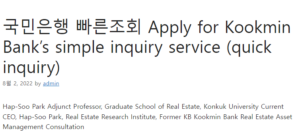Hap-Soo Park Adjunct Professor, Graduate School of Real Estate, Konkuk University Current CEO, Hap-Soo Park, Real Estate Research Institute, Former KB Kookmin Bank Real Estate Asset Management Consultation
The government announced the economic policy direction on June 16. The direction of the broad framework is, in a word, regulatory innovation. The main goal is to prevent excessive new regulations and introduce innovative deregulation measures to reorganize regulations that have been traditionally operated for a long time. Considering that the flow of the market economy has been excessively restricted by excessive regulation, 국민은행 빠른조회

this is a desirable direction. As this is the first policy introduced after the inauguration of the government, there are many things that need to be improved, but it is meaningful in terms of opening the door. Among them, let’s focus on the real estate market normalization sector. 이베이스매뉴얼
First, the first step to stabilizing the housing market is to expand housing supply. As a basic work, a “high-density residential area” will be newly established to have high-density residential functions in order to expand the supply of the city center. An “urban innovation planning zone” will also be introduced so that private businesses can develop freely without restrictions. In addition, a ‘complex use planning zone’ is created for the convergence and convergence of urban functions such as residential, commercial and leisure areas. Large cities such as Seoul are facing the limit of available urban land for development.
It is a must-review for the efficient use of limited urban land. It is an expected direction in the sense of raising the development floor area ratio, granting autonomy, and achieving convergence and convergence of urban functions.
In order to promote sufficient housing supply, a plan to reform the price ceiling system will also be announced. It is also planning to prepare a roadmap for supplying 2.5 million units nationwide, which was mentioned first in the pledge, within the third quarter.
The price ceiling system fails to achieve the purpose of stabilizing housing prices and has many side effects, such as being pointed out as a cause of supply delay, so it should be abolished rather than improved. Finally, as the mandatory residence period was granted to private apartments, the effect of stabilizing the jeonse market, which was seen when moving into a new apartment, was also halved. As an alternative, the housing price review system of the Housing and Urban Guarantee Corporation (HUG) should be rationally improved. Housing supply of 2.5 million units (500,000 units per year) is the most anticipated sector.
As it was the biggest cause of the rise in housing prices during the previous government, it is necessary to prepare as soon as possible. Currently, the supply of the third new city is in progress, but there are about 5-6 years left until move-in. The supply policy currently being promoted is also highly likely to be implemented by the next government. Nevertheless, it is important to give a stable signal to the market as soon as possible. In addition, in order to revitalize the supply of downtown areas such as Seoul, it is necessary to speed up the development of maintenance projects such as reconstruction and redevelopment.
It is necessary to review all directions, such as easing the reconstruction safety diagnosis standards, abolishing the prohibition on transfer of union membership, and abolishing the system for recovering excess profits from reconstruction. The first phase of the new town redevelopment project should also be promoted quickly. As infrastructure improvements such as GTX are made in this area, an additional supply of more than 100,000 units is sufficient. It is also necessary to change the policy to increase the volume of the 3rd new town itself by about 150,000 units. It is possible to increase the proportion of housing supply by reducing the excessively allocated park and green space and converting the self-sufficient land into residential land (about 26%).